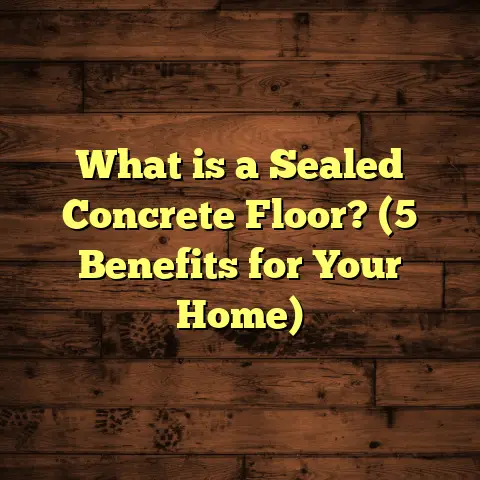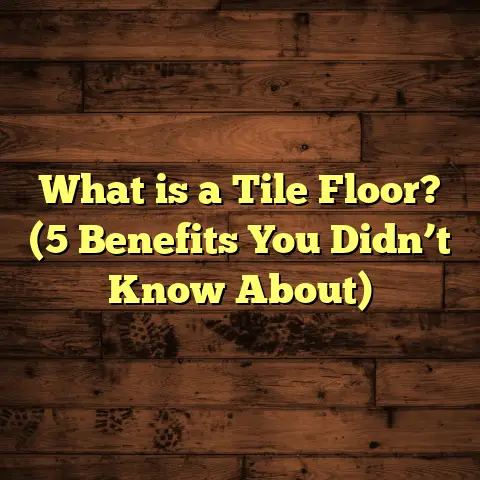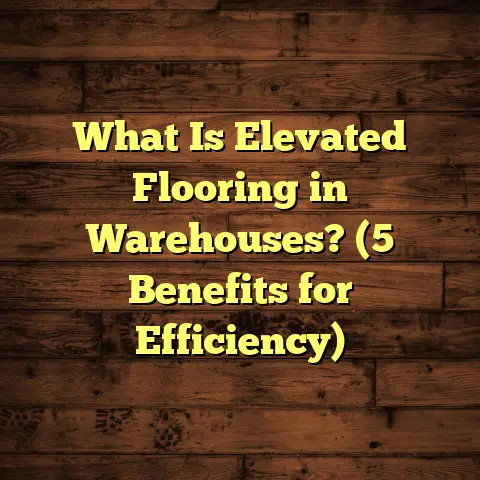What is an Engineered Floor? (5 Benefits You Didn’t Know!)
What is an Engineered Floor?
You know, over the years I’ve noticed that flooring trends change a lot. Sometimes, it feels like every season there’s a new “must-have” floor style. But engineered flooring has been steadily growing in popularity, and it’s one of those options that’s not just a fad—it’s here to stay. I want to share what I’ve learned and experienced about engineered floors because they really bring something unique to the table.
So, what exactly is an engineered floor? At its core, engineered flooring is a type of wood flooring made up of multiple layers stacked and bonded together. The very top layer is a thin slice of real hardwood—oak, maple, hickory, or whatever species you prefer. But beneath that is where it gets interesting: underneath the hardwood veneer there are layers of plywood or high-density fiberboard (HDF), arranged so their grain runs perpendicular to the layer above. This cross-layered construction is key to the floor’s strength and stability.
I still remember when I first encountered engineered flooring on a job for a client who wanted hardwood but had a basement space with potential moisture issues. They were hesitant because solid hardwood was the traditional choice, perceived as the “real” wood floor. But I explained how engineered floors work and showed them samples. The layered design prevents many of the problems solid hardwood faces in moist or unstable environments. They ended up loving it—not only because it looked great but also because it gave them peace of mind about durability.
Engineered floors aren’t just practical—they come in so many finishes and wood species that you can find something to match almost any style or décor. Whether you want a rustic farmhouse look with distressed oak or something sleek and modern like walnut with a satin finish, engineered floors deliver.
Why Are Engineered Floors Becoming So Popular?
Before getting into the benefits, I want to share why I think engineered floors have gained so much traction recently. For one, people are spending more time improving their homes these days. Flooring is a huge part of that because it impacts both aesthetics and comfort.
But here’s the catch: homeowners want authentic wood but struggle with the downsides of traditional hardwood in certain spaces. Basements, kitchens, even some living rooms can be tricky because of humidity, temperature swings, or subfloor conditions.
Engineered floors fill that gap perfectly. They offer the look and feel of real wood but with fewer limitations on where you can install them.
Plus, installation has gotten easier over the years. Many engineered floors now come with click-lock systems that snap together without glue or nails. This makes them popular for DIYers and cuts down on installation time and costs.
In my own work, I’ve seen more clients asking for engineered floors over solid hardwood simply because they want a beautiful floor that lasts without constant worry about damage.
5 Benefits You Didn’t Know About Engineered Floors
1. Exceptional Stability in Variable Environments
One of the biggest advantages—and this might surprise you—is how stable engineered floors are when the climate changes. Unlike solid hardwood that can expand or shrink drastically with moisture and temperature fluctuations, engineered floors resist these movements.
Why? Because of their layered structure. Each layer is oriented differently, which balances out stresses caused by humidity or heat.
I’ve worked in different parts of the country—from dry mountain towns to humid coastal areas—and noticed engineered floors consistently outperform solid hardwood in staying flat and intact.
To back this up with numbers: According to the National Wood Flooring Association (NWFA), engineered wood flooring can reduce dimensional changes by up to 50% compared to solid wood. This means fewer gaps between boards or cupping effects over time.
If you plan to install flooring in a basement or near a kitchen sink where spills happen often, engineered flooring’s resistance to moisture makes it a smart choice.
2. Faster, More Flexible Installation Options
Think about how much time you spend prepping for an install or fixing mistakes during flooring installation. Engineered floors simplify this process dramatically.
Most engineered floors feature tongue-and-groove edges or click-lock systems that allow planks to snap together easily without nails or glue.
I remember a project where we installed an engineered floor over existing vinyl in a rental unit. The entire install took half the time we’d normally spend on subfloor prep and nailing down solid hardwood.
This ease translates directly into cost savings since less labor time means lower bills.
On top of that, engineered flooring can be installed as a floating floor—meaning it’s not glued or nailed down—which works well over concrete slabs or radiant heating systems.
When managing costs for jobs like this, I use FloorTally—a tool that helps me calculate material needs and labor costs accurately based on local rates. It saves me from ordering too much or too little material and helps clients understand exactly what their budget looks like before work starts.
3. A More Environmentally Friendly Choice
If you care about sustainability (and who doesn’t?), engineered wood flooring can be a better option than solid hardwood.
Because only the top veneer layer is real hardwood, manufacturers use less slow-growing timber overall. The core layers often come from faster-growing trees or recycled wood fibers.
Here’s an interesting fact: research shows that engineered wood uses up to 70% less solid hardwood per square foot installed compared to traditional flooring.
Many brands also pursue certifications from organizations like the Forest Stewardship Council (FSC) ensuring responsible forest management.
I’ve had clients tell me they’d never considered environmental impact when choosing flooring but felt more comfortable selecting engineered wood once they understood this advantage.
4. Perfect for More Spaces Than You Might Think
One thing I love about engineered floors is their versatility. Since they’re more stable and moisture-resistant than solid wood, you can install them in spaces that would otherwise be off-limits for hardwood.
Basements, for example, often have concrete slabs prone to moisture seepage—solid hardwood isn’t recommended here because it could warp. But engineered flooring does well if installed properly with moisture barriers.
I’ve also installed engineered floors in kitchens and laundry rooms where water exposure is common but beauty matters too.
Even some commercial spaces benefit from engineered hardwood because it offers durability without sacrificing style.
For coastal homes with salty air and high humidity, engineered hardwood is often the best flooring choice since it holds up better than regular wood under these tough conditions.
5. Longevity with Simple Maintenance
You might wonder how long engineered floors last compared to solid hardwood. The answer is: quite long when cared for properly.
The wear layer on top—usually between 2mm to 6mm thick—can be sanded and refinished several times depending on its thickness. This means you can restore its beauty if it gets scratched or dull over time.
From my experience managing hundreds of flooring projects over the years, many engineered floors remain beautiful for 20 years or more with regular upkeep.
Simple maintenance involves sweeping or vacuuming regularly and wiping spills quickly with a damp cloth using recommended cleaners.
One client I worked with had an engineered oak floor installed 15 years ago in their living room; it still looks fantastic today after periodic refinishing.
My Experience Installing Engineered Floors: Lessons from Real Jobs
Let me tell you about a particular job that stands out in my memory because it perfectly highlights why I recommend engineered flooring so often.
A young family wanted to finish their basement into a cozy hangout spot but were worried about moisture ruining traditional hardwood floors. After discussing options, we chose a mid-tone walnut engineered floor with a matte finish.
The installation went smoothly—the click-lock system sped things up significantly compared to older methods I’d used before. We floated the floor over a vapor barrier they had installed on the concrete slab below.
What impressed me most was how well those floors held up through seasonal changes over two years since installation. No warping or gaps appeared despite occasional humidity spikes in summer months.
That family was thrilled because they got the warm look they wanted without sacrificing durability—something that might not have been possible with solid hardwood in their basement environment.
Breaking Down Engineered Floor Construction
Understanding what goes into an engineered floor helps explain why it performs so well.
- Top Layer (Wear Layer): This is real hardwood veneer that provides the natural wood look and finish.
- Core Layers: Typically plywood or HDF layers stacked crosswise to add strength.
- Bottom Layer (Backing): Balances moisture movement and adds stability.
The thickness of these layers varies depending on product quality and price point. Higher-end engineered floors usually feature thicker veneers and multiple plywood layers for enhanced durability.
The cross-layered construction resists cupping and swelling because each layer counteracts movement from adjacent layers—a bit like how plywood is stronger than a single piece of wood large enough for its size.
How Engineered Floors Compare Cost-Wise
You’re probably curious how engineered flooring stacks up cost-wise compared to alternatives like solid hardwood or laminate flooring.
Here’s what I’ve seen:
- Engineered floors typically cost less per square foot than comparable solid hardwood.
- Installation costs can be lower due to easier installation methods.
- Long-term maintenance costs are similar because refinishing may be needed eventually.
- Compared to laminate (which mimics wood but isn’t real), engineered flooring usually costs more upfront but delivers better longevity and resale value.
Using FloorTally has helped me calculate these budgets accurately across many projects by factoring in material prices locally, labor rates, installation complexity, and waste percentages.
I remember one kitchen remodel where we compared laminate vs engineered hardwood options using FloorTally outputs. The client appreciated seeing detailed cost breakdowns which helped them decide on engineered wood despite higher initial cost because they valued durability and authentic appearance more.
What About Durability? Can Engineered Floors Handle Heavy Traffic?
Absolutely! Engineered floors are built to last through normal wear and tear—and many come with high-performance finishes resistant to scratches and stains.
I’ve installed them in homes with kids and pets where foot traffic was heavy daily—and the floors held up well without needing repairs for years.
Some manufacturers offer aluminum oxide coatings which greatly improve scratch resistance compared to traditional finishes.
For commercial use, certain engineered planks are designed specifically for high-traffic environments. They might have thicker veneers or reinforced cores to withstand constant use.
Are There Any Downsides?
No product is perfect, right? So I’ll be upfront about some things you should keep in mind with engineered flooring:
- The wear layer is thinner than solid hardwood, so refinishing options are limited depending on product quality.
- Cheaper versions may use lower-grade plywood cores that don’t perform as well over time.
- Repairs can be trickier than with solid wood if planks get damaged badly—you might need to replace sections rather than sanding down.
- Some people prefer the feel of solid wood underfoot; engineered wood can feel slightly different due to its layered construction.
- Installation still requires some care; improper subfloor prep can lead to problems like squeaking or gaps later on.
Despite these minor caveats, I find that good-quality engineered floors installed correctly offer excellent value for many applications.
What’s New in Engineered Flooring Technology?
You might be surprised at how much innovation has gone into engineered floors recently!
- Wider Planks: Modern engineered floors come in wider board widths (6–9 inches) than older products due to improved manufacturing processes.
- Enhanced Finishes: New UV-cured aluminum oxide finishes give better protection without changing wood’s natural texture.
- Waterproof Variants: Some brands now offer waterproof engineered wood options that combine real wood surface with waterproof cores—ideal for bathrooms or basements.
- Eco-Friendly Manufacturing: Advances include using formaldehyde-free adhesives and sustainably harvested timber.
- Underfloor Heating Compatibility: Engineered floors adapt better to radiant heat systems without cracking compared to solid hardwood.
Keeping up with these developments allows me to recommend cutting-edge products tailored specifically to each client’s needs.
Debunking Common Myths About Engineered Flooring
Over the years I’ve heard plenty of misconceptions about engineered floors from clients and friends:
- Myth: “Engineered wood isn’t real wood.” Truth: The top layer is real hardwood; only the core layers are plywood or HDF.
- Myth: “It won’t last as long as solid hardwood.” Truth: High-quality engineered floors last decades with proper care.
- Myth: “You can’t refinish it.” Truth: Depending on veneer thickness, multiple refinishing cycles are possible.
- Myth: “It’s not environmentally friendly.” Truth: Engineered wood uses less harvested timber overall than solid hardwood.
Addressing these myths helps clients make informed decisions without unnecessary doubts.
Maintenance Tips That Keep Engineered Floors Looking Great
To keep your engineered floor looking beautiful for years:
- Sweep or vacuum regularly using soft-bristle attachments.
- Clean spills immediately with a damp cloth; never let water sit on the surface.
- Avoid harsh chemicals or abrasive pads; use cleaner recommended by manufacturer.
- Place mats at entryways to reduce dirt tracked indoors.
- Use furniture pads under legs to prevent scratches.
- Refinish when wear layer shows signs of thinning or dullness (if your floor allows).
Following these simple steps has helped my clients avoid premature wear and maintain showroom shine easily.
Case Study: Engineered Flooring in a Coastal Home
A few years ago I worked on a beachside property where salty air caused constant issues for traditional wood floors due to warping and discoloration.
We installed high-quality engineered flooring with a thick wear layer finished in matte oak stain resistant to UV damage.
After three years of seasonal storms and humidity swings, the floor remained flawless—no cupping or gaps developed despite tough conditions.
The homeowners were relieved since previously they had replaced solid hardwood twice within five years due to damage. This experience reinforced my belief that engineered wood can be ideal for challenging environments when installed properly.
How To Choose The Right Engineered Floor For Your Home
Choosing an engineered floor isn’t just about picking color and species—there are several technical factors to consider:
- Wear Layer Thickness: Thicker layers (4mm or more) allow more refinishing; thinner layers limit lifespan.
- Core Material: High-quality plywood tends to perform better than HDF in terms of stability.
- Finish Type: Matte finishes hide scratches better; glossy finishes emphasize grain but show wear sooner.
- Installation Method: Decide between glue-down, nail-down, or floating based on subfloor type.
- Warranty: Look for products offering robust warranties covering wear-through or structural defects.
I always help clients weigh these elements based on their lifestyle needs—for example families with kids usually want thicker wear layers and durable finishes while someone renovating a rental might prioritize ease of installation and price point.
Final Thoughts: Is Engineered Flooring Right For You?
From my experience installing hundreds of floors over many years across various climates and building types, I’m confident that engineered flooring offers an outstanding balance between beauty, durability, and flexibility.
It suits homeowners who want authentic wood look without worrying about moisture damage or complex installs. It fits spaces ranging from traditional living rooms to moisture-prone basements where solid hardwood isn’t practical.
If you’re thinking about upgrading your flooring but aren’t sure whether solid hardwood fits your home environment or budget constraints, considering an engineered option could be wise.
Got questions about your project? Need help deciding if an engineered floor fits your style and space? Just ask—I’m happy to share what I’ve learned firsthand!





